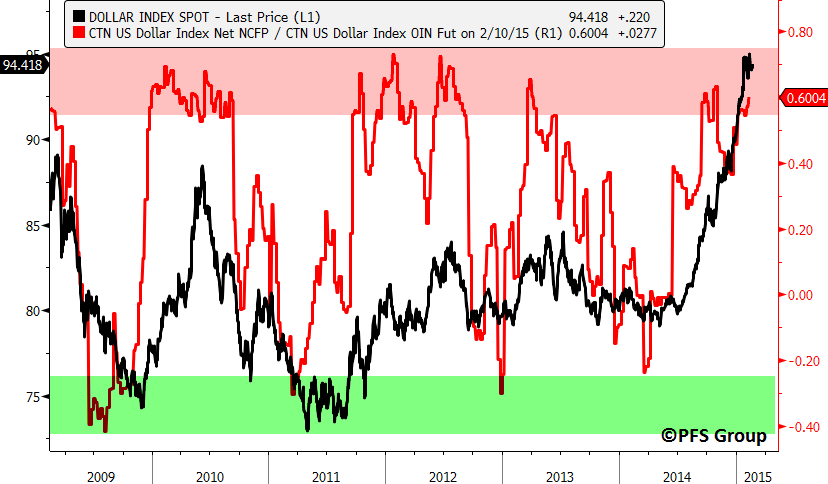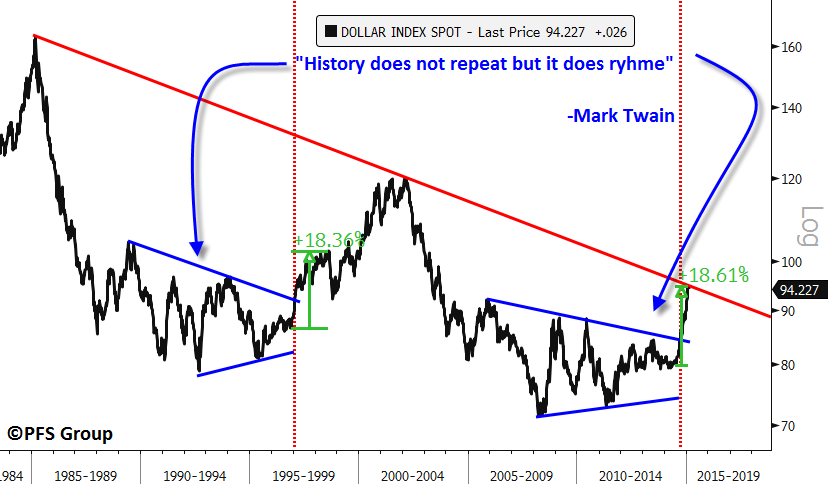Overview
- USD bullish sentiment at extremes as is Euro bearish sentiment
- USD likely to correct in coming weeks and months based on several factors
- Given importance of USD in the global economy, this has widespread investment implications
One of the best investments over last year was the US dollar (USD) as it exploded more than 20% higher from its May 2014 lows and recently hit its highest levels since 2003. Question is, why the dollar rise and not fall as many had long predicted? Much of the dollar's strength had to do with rising interest rate and growth differentials between the US and the rest of the world. Additionally, the Fed scaled out of its QE program while we’ve seen both the Bank of Japan (BOJ) and the European Central Bank (ECB) step on the accelerator.
Sentiment at Extreme Levels
As the strengthening trend in the USD has continued, more investors turned bullish on the currency, pushing sentiment to extreme levels. Here, we see net long futures positions in the USD by speculators as a share of total open interest (shown in red below) is near multi-year highs, which typically marks a top in the USD Index (shown in black) and suggests the USD is susceptible to a pullback at these levels.
Smart Money Betting Big on Dollar Pullback
Looking at the absolute net long positioning in USD futures by speculators shows the largest ever net long exposure (shown in red in the middle panel) while commercial hedgers (AKA: the “smart money”) have the biggest net short position (blue line, bottom panel) in the history of the data. Whenever we see spikes higher in net long speculator positions and extreme net short commercial positions, the USD has tended to correct in the following weeks and months.
Euro Likely to Bounce
While USD bullish sentiment is at record high levels, sentiment towards to Euro couldn’t be any more depressed according to Consensus Euro sentiment data. Jeff deGraaf at Renaissance Macro Research took a historical look at what the forward returns were for the Euro when sentiment reached 20% or below as it did recently. There were 8 occurrences since 2000 and the Euro rallied a median 2.58% 65 days out and was positive 75% of the time, while it rallied 7.17% 250 days out and was positive 87.5% of the time. This means there is a strong likelihood we will be looking at a higher Euro several months out. Also, given the Euro's 57.6% weighting in the USD Index, the dollar is likely to correct in the coming months.

Source: Renaissance Macro Research (used with permission)
1) Mean Reversion
There are three likely causes for the USD Index to correct in the coming months with one of them being mean reversion. Mean reversion is akin to a stretched rubber band that snaps back after being stretched too far. There are several relationships that suggest the USD Index has been stretched too far and should snap back and mean revert. One of them is the relative central bank balance sheet between the ECB and the Fed. When the Fed’s balance sheet expands at a faster pace than the ECB we see the Euro rally relative to the USD and vice versa. It was not surprising to see the Euro begin to weaken in 2014 as the Fed’s relative balance sheet size began to shrink compared to the ECB as US QE was being wound down. However, we see that the Euro/USD exchange rate is now below the lows seen in 2010 and 2012 while the Fed/ECB balance sheet ratio is well above the lows seen in those years. This implies investors have discounted fully the majority of the new ECB QE program that is to go into place to at least September 2016 even though it hasn't officially started. As well, investors have likely overshot the Euro to the downside and a Euro rally could be in the works.
Along the lines of relative monetary policy, we see the USD Index rally when the Fed’s target rate rises relative to the ECB’s main refinancing rate and the sharp move higher by the USD Index implies investors are betting the US Fed to increase rates by more than 1% above the ECB’s rate in the coming months—highly unlikely. Whenever we’ve seen the USD Index spike well north of the interest rate differential (see yellow boxes below) we often see the USD Index correct.
It isn’t the ECB and Fed interest rate differential that suggests the USD Index rally is overdone. I’ve created a central bank spread composite with the same weights of the currencies in the USD Index and the rate spread shows a decent correlation to the USD Index’s year-over-year appreciation and whenever the USD Index rallies well above what would be suggested by the central bank spread we’ve seen the USD Index correct.
2) Global Economic Recovery
In addition to the mean reversion argument, a second catalyst is a bottoming in global economic growth. As was argued in a previous article (click for link) we are likely to see global growth bottom in coming weeks which would reduce the premium for growth afforded to the US economy. In particular, we should see a European recovery in the months ahead based on the leading economic indicators shown below, which should lead to a strengthening Euro and subsequent weakness in the USD.
3) Technical Resistance
Outside of the sentimental and fundamental arguments for the USD Index to correct in the months ahead, there is also a technical argument for the USD Index to decline as it is hitting major trend resistance from the middle 1980s top and the early 2000s top. The USD should stall near this resistance.
The other interesting development is that we appear to be going through a replay of the late 1990s in which the USD Index broke out of a triangle pattern and shot up like a rocket by roughly 18% before correcting. While the USD made that move in the late 1990s over a 1.5 year period the current USD rally has made the same move in only seven months. The USD corrected by roughly 10% in 1998 and we could see a similar correction in the weeks and months ahead.
Summary
The USD has experienced a sharp rally over the last year and bullish sentiment towards the greenback is reaching frothy levels as speculative long futures positioning has hit an all-time high. At the same time, commercial hedgers (AKA: “Smart Money”) are at a record short position. Additionally, sentiment towards other major currencies like the Euro are reaching bearish extremes and we could be in store for a significant USD correction caused by mean reversion, renewed global growth, and technical factors.
If the USD corrects it will be repeating a similar pattern that occurred in the late 1990s and, given the USD’s reserve currency status, a decline in the USD will have widespread implications and provide great investment opportunities which will be outlined in my next article.













